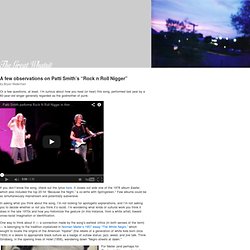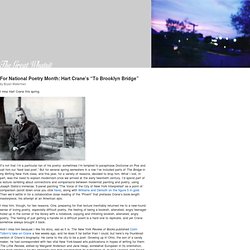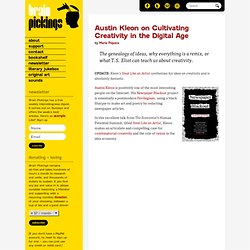

40 Modern Nonfiction Books Everyone Should Read. Literary Kicks. Letters of Note – John Steinbeck: "It has never got easier" Remembering an inspiring teacher - Life stories. About two months ago, we lost a great man.

His name was Jay Criche, and he was a teacher. He taught English for 30 years, 23 of them at Lake Forest High School. N1BR. Walt Whitman, Frankenstein, Dracula, and the Afterlife. The smallest sprout shows there is really no death,And if ever there was it led forward life, and does not wait at the end to arrest it,And ceas'd the moment life appear'd.

All goes onward and outward, nothing collapses,And to die is different from what anyone supposed, and luckier. [“Song of Myself,” section 6] Walt Whitman always wrote with great authority, even eagerness, about death. “Sane and sacred,” he calls it in “When Lilacs Last in the Dooryard Bloom’d,” his great elegy for President Lincoln. Just another manic Monday « The Great Whatsit. Postscripts, follow-ups, and a few odds and ends I’ve wanted to share for a while: 1.

Nostalgia or counternostalgia? The Jon Kessler Experience VBS.tv has a little four-part Art Talk! Interview with a friend of mine, Jon Kessler, who set up studio space out in Williamsburg in 1980. 2. Also following up my “Magic of this broken world” posts is a line or two that stuck out at me while leading a book group discussion on part II of Luc Sante’s Low-Life sometime last week. Bowery characters [eccentrics who had achieved local notoriety for flamboyant drinking and storytelling] acquired a professional venue at Sammy’s Bowery Follies, which opened at number 267, on the site of some notorious dives of the past, such as McGurk’s the Mug. Now, the Bowery today is certainly a different world than it was 15+ years ago, when Sante’s narrative — the consummate nostaglic New York loveletter — was published. 3. 4. A few observations on Patti Smith’s “Rock n Roll Nigger” « The Great Whatsit. Or a few questions, at least.

I’m curious about how you read (or hear) this song, performed last year by a 60-year-old singer generally regarded as the godmother of punk: If you don’t know the song, check out the lyrics here. It closes out side one of the 1978 album Easter, which also included the top 20 hit “Because the Night,” a co-write with Springsteen.* Few albums could be so simultaneously mainstream and potentially subversive.
In asking what you think about the song, I’m not looking for apologetic explanations, and I’m not asking you to decide whether or not you think it’s racist. For National Poetry Month: Hart Crane’s “To Brooklyn Bridge” « The Great Whatsit. I miss Hart Crane this spring.

It’s not that I’m a particular fan of his poetry: sometimes I’m tempted to paraphrase Doctorow on Poe and call him our “best bad poet.” But for several spring semesters in a row I’ve included parts of The Bridge in my Writing New York class, and this year, for a variety of reasons, decided to drop him. What I lost, in part, was the need to explain modernism once we arrived at the early twentieth century. I’d spend part of a lecture rambling about connections and comparisons between modernist painting and poetry, using Joseph Stella’s immense, 5-panel painting “The Voice of the City of New York Interpreted” as a point of comparison (scroll down once you click here), along with Williams and Demuth on the figure 5 in gold. Then we’d settle in for a collaborative close reading of the “Proem” that prefaces Crane’s book-length masterpiece, his attempt at an American epic.
The Artist and the Corporation: A Brief Meditation on the DIY Publishing Experience. Directory. Oxford American - The Southern Magazine of Good Writing. Austin Kleon on Cultivating Creativity in the Digital Age. By Maria Popova The genealogy of ideas, why everything is a remix, or what T.S.

Eliot can teach us about creativity. UPDATE: Kleon’s Steal Like an Artist synthesizes his ideas on creativity and is absolutely fantastic. Austin Kleon is positively one of the most interesting people on the Internet. His Newspaper Blackout project is essentially a postmodern florilegium, using a black Sharpie to make art and poetry by redacting newspaper articles.
In this excellent talk from The Economist‘s Human Potential Summit, titled Steal Like an Artist, Kleon makes an articulate and compelling case for combinatorial creativity and the role of remix in the idea economy. Kleon, who has clearly seen Kirby Ferguson’s excellent Everything is a Remix, echoes the central premise of my own recent talk on networked knowledge and combinatorial creativity: Nothing is completely original. Amen. And even more in the vein of the Brain Pickings ethos, reminiscent of this favorite quote by iconic designer Paula Scher: The Drum Literary Magazine. Beyond The Margins Literary Kicks.